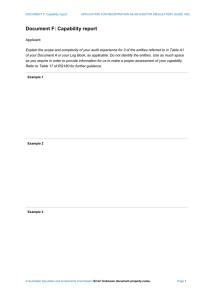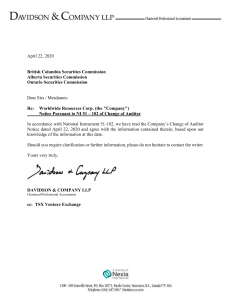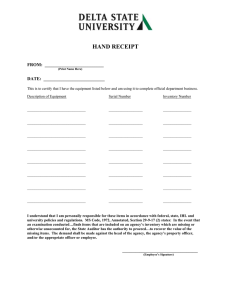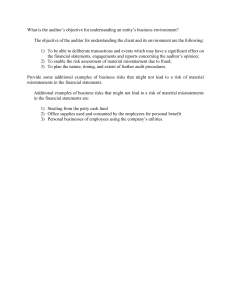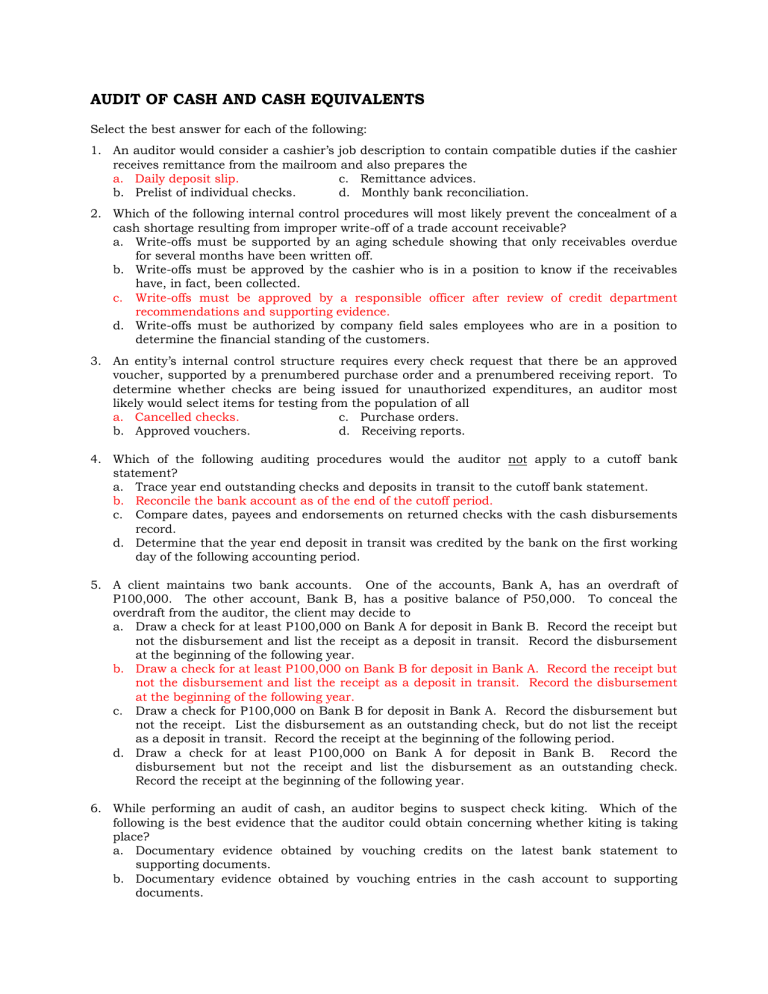
AUDIT OF CASH AND CASH EQUIVALENTS Select the best answer for each of the following: 1. An auditor would consider a cashier’s job description to contain compatible duties if the cashier receives remittance from the mailroom and also prepares the a. Daily deposit slip. c. Remittance advices. b. Prelist of individual checks. d. Monthly bank reconciliation. 2. Which of the following internal control procedures will most likely prevent the concealment of a cash shortage resulting from improper write-off of a trade account receivable? a. Write-offs must be supported by an aging schedule showing that only receivables overdue for several months have been written off. b. Write-offs must be approved by the cashier who is in a position to know if the receivables have, in fact, been collected. c. Write-offs must be approved by a responsible officer after review of credit department recommendations and supporting evidence. d. Write-offs must be authorized by company field sales employees who are in a position to determine the financial standing of the customers. 3. An entity’s internal control structure requires every check request that there be an approved voucher, supported by a prenumbered purchase order and a prenumbered receiving report. To determine whether checks are being issued for unauthorized expenditures, an auditor most likely would select items for testing from the population of all a. Cancelled checks. c. Purchase orders. b. Approved vouchers. d. Receiving reports. 4. Which of the following auditing procedures would the auditor not apply to a cutoff bank statement? a. Trace year end outstanding checks and deposits in transit to the cutoff bank statement. b. Reconcile the bank account as of the end of the cutoff period. c. Compare dates, payees and endorsements on returned checks with the cash disbursements record. d. Determine that the year end deposit in transit was credited by the bank on the first working day of the following accounting period. 5. A client maintains two bank accounts. One of the accounts, Bank A, has an overdraft of P100,000. The other account, Bank B, has a positive balance of P50,000. To conceal the overdraft from the auditor, the client may decide to a. Draw a check for at least P100,000 on Bank A for deposit in Bank B. Record the receipt but not the disbursement and list the receipt as a deposit in transit. Record the disbursement at the beginning of the following year. b. Draw a check for at least P100,000 on Bank B for deposit in Bank A. Record the receipt but not the disbursement and list the receipt as a deposit in transit. Record the disbursement at the beginning of the following year. c. Draw a check for P100,000 on Bank B for deposit in Bank A. Record the disbursement but not the receipt. List the disbursement as an outstanding check, but do not list the receipt as a deposit in transit. Record the receipt at the beginning of the following period. d. Draw a check for at least P100,000 on Bank A for deposit in Bank B. Record the disbursement but not the receipt and list the disbursement as an outstanding check. Record the receipt at the beginning of the following year. 6. While performing an audit of cash, an auditor begins to suspect check kiting. Which of the following is the best evidence that the auditor could obtain concerning whether kiting is taking place? a. Documentary evidence obtained by vouching credits on the latest bank statement to supporting documents. b. Documentary evidence obtained by vouching entries in the cash account to supporting documents. c. Oral evidence obtained by discussion with controller personnel. d. Evidence obtained by preparing a schedule of interbank transfers. 7. Two months before year-end, the bookkeeper erroneously recorded the receipt of a long-term bank loan by a debit to cash and a credit to sales. Which of the following is the most effective procedure for detecting this type of error? a. Analyze bank confirmation information. b. Analyze the notes payable journal. c. Prepare year-end bank reconciliation. d. Prepare a year-end bank transfer schedule. 8. Postdated checks received by mail in settlement of customer’s accounts should be a. Returned to customer. b. Stamped with restrictive endorsement. c. Deposited immediately by the cashier. d. Deposited the day after together with cash receipts. 9. The cashier of Milady Jewelries covered a shortage in the cash working fund with cash obtained at December 31 from a bank by cashing but not recording a check drawn on the company out of town bank. How would you as an auditor discover the manipulation? a. By confirming all December 31 bank balances. b. By counting the cash working fund at the close of business on December 31. c. By investigating items returned with the bank cut-off statements of the succeeding month. d. By preparing independent bank reconciliations as of December 31 10. An essential phase of the audit of the cash balance at the end of the year is the auditor's review of cutoff bank statement. This specific procedure is not useful in determining if a. Kiting has occurred. b. Lapping has occurred. c. The cash receipts journal was held open. d. Disbursements per the bank statement can be reconciled with total checks written. Answers: 1) A; 2) C; 3) A; 4) B, 5) B; 6) D; 7) A; 8) B; 9) C; 10) B AUDIT OF INVENTORIES Select the best answer for each of the following: 1. Otso Manufacturing Corporation mass produces eight different products. The controller, who is interested in strengthening internal controls over the accounting for materials used in production, would be most likely to implement a. A separation of duties among production personnel. b. A perpetual inventory system. c. An economic order quantity (EOQ) system. d. A job order cost accounting system. 2. Which of the following control procedures would most likely be used to maintain accurate perpetual inventory records? a. Independent matching of purchase orders, receiving reports, and vendors' invoices. b. Independent storeroom count of goods received. c. Periodic independent reconciliation of control and subsidiary records. d. Periodic independent comparison of records with goods on hand. 3. The accuracy of perpetual inventory records may be established in part by comparing perpetual inventory records with a. Purchase requisitions. c. Receiving reports. b. Purchase orders. d. Vendor payments. 4. The auditor tests the quantity of materials charged to work in process by tracing these quantities to a. Receiving reports. c. Materials requisition forms. b. Perpetual inventory records. d. Cost ledgers. 5. An auditor would analyze inventory turnover rates to obtain management’ s assertion about a. Valuation or allocation. c. Presentation and disclosure. b. Rights and obligations. d. Completeness evidence concerning 6. In auditing inventories, a major objective relates to the existence assertion. Of the following audit procedures relating to inventories, which does not support the existence assertion? a. The auditor reviews the client's inventory-taking instructions for such matters as proper arrangement of goods, separation of consigned goods, and limits on movements of goods during inventory. b. The auditor observes the client's inventory and performs test counts as appropriate. c. The auditor confirms inventories not on the premises. d. The auditor performs a lower of cost or market test for major categories of inventory. 7. In a manufacturing company, which one of the following audit procedures would give the least assurance of the valuation of inventory at the audit date? a. Obtaining confirmation of inventories pledged under loan agreements. b. Testing the computation of standard overhead rates. c. Examining paid vendors' invoices. d. Reviewing direct labor rates. 8. When auditing merchandise inventory at year end, the auditor performs a purchase cutoff test to obtain evidence that a. No goods held on consignment for customers are included in the inventory balance. b. No goods observed during the physical count are pledged or sold. c. All goods owned at year end are included in the inventory balance d. All goods purchased before year end are received before the physical inventory count. 9. Which of the following items should not be included in a physical inventory? a. Materials in transit from vendors. b. Goods in a private warehouse. c. Goods received for repairs under warranty. d. Consignment to an agent. 10. You were engaged to conduct an annual examination for the fiscal year ended October 31, 2006. Because of the expected holiday, you were able to convince your client to take a complete physical inventory, in which you were present on October 15. Perpetual inventory records are kept and the client considers a sale to be made in the period in which goods are shipped. You had a sales cutoff test worksheet prepared. Which item among those listed below will not require an adjusting entry to reconcile the client's detailed inventory record with the physical inventory? a. b. c. d. Date Goods Shipped Oct 31 Nov 2 Oct 14 Oct 10 Transaction Recorded as Sale Nov 2 Oct 31 Oct 16 Oct 19 Date Inventory Control Credited Oct 31 Oct 31 Oct 16 Oct 12 Answers: 1) B; 2) D; 3) C; 4) C, 5) A; 6) D; 7) A; 8) C; 9) C; 10) D AUDIT OF INVESTMENTS Select the best answer for each of the following: 1. Which of the following is not a control that is designed to protect investment securities? a. Access to securities should be vested in more than one individual. b. Securities should be properly controlled physically in order to prevent unauthorized usage. c. Securities should be registered in the name of the owner. d. Custody over securities should be limited to individuals who have recordkeeping responsibility over the securities. 2. Which of the following controls would a company most likely use to safeguard investment securities when an independent trust agent is not employed? a. The chairman of the board verifies the investment securities, which are kept in a bank safe deposit box, each year on the balance sheet date. b. The investment committee of the board of directors periodically reviews the investment decisions delegated to the treasurer. c. Two company officials have joint control of investment securities, which are kept in a bank safe deposit box. d. The internal auditor and the controller independently trace all purchases and sales of investment securities from the subsidiary ledgers to the general ledger. 3. Which of the following controls would an entity most likely use to assist in satisfying the completeness assertion related to long-term investments? a. The controller compares the current market prices of recorded investments with the brokers’ advices on file. b. Senior management verifies that securities in the bank safe deposit box are registered in the entity’ s name. c. The internal auditor compares the securities in the bank safe deposit box with recorded investments. d. The treasurer vouches the acquisition of securities by comparing brokers’ advices with canceled checks. 4. Which of the following controls would an entity most likely use in safeguarding against the loss of investment securities? a. A designated member of the board of directors controls the securities in a bank safe deposit box. b. An independent trust company that has no direct contact with the employees who have record-keeping responsibilities has possession of securities. c. The internal auditor verifies the investment securities in the entity’ s safe each year on the balance sheet date. d. The independent auditor traces all purchases and sales of investment securities through the subsidiary ledgers to the general ledger. 5. When negotiable securities are of considerable volume, planning by the auditor is necessary to guard against a. Substitution of securities already counted for other securities which should be on hand but are not. b. Substitution of authentic securities with counterfeit securities. c. Unauthorized negotiation of the securities before they are counted. d. Unrecorded sales of securities after they are counted. 6. In a. b. c. d. auditing investments for proper valuation, the auditor should do all but the following: Vouch purchases and sales of securities by tracing to brokers' advices and canceled checks. Compare cost and market by reference to year end market values for selected securities. Confirm securities held in safekeeping off the client's premises. Recalculate gain or loss on disposals. 7. An audit procedure that provides evidence about proper valuation of trading securities arising from a short-term investment of excess cash is a. Recalculation of investment carrying value by applying the equity method. b. Comparison of carrying value with current market quotations. c. Confirmation of securities held by broker. d. Calculation of premium or discount amortization. 8. The auditee has acquired another company by purchase. Which of the following would be the best audit procedure to test the appropriateness of the allocation of cost to tangible assets? a. Evaluate procedures used to estimate and record fair market values for purchased assets. b. Determine whether assets have been recorded at their book value at the date of purchase. c. Evaluate the reasonableness of recorded values by discussion with operating personnel. d. Evaluate the reasonableness of recorded values by use of replacement cost data. 9. The auditee has just acquired another company by purchasing all its assets. As a result of the purchase, "goodwill" has been recorded on the auditee's books. Which of the following comparisons would be the most appropriate audit test for the amount of recorded goodwill? a. The purchase price and the fair market value of assets purchased. b. The purchase price and the book value of assets purchased. c. The figure for goodwill specified in the contract for purchase. d. Earnings in excess of 15% of net assets for the past five years. 10. Of the following, which is the most efficient audit procedure for testing accrued interest earned on bond investments? a. Vouching the receipt and deposit of interest checks. b. Tracing interest declarations to an independent record book. c. Recomputing interest earned. d. Confirming interest rate with the issuer of the bonds. Answers: 1) D; 2) C; 3) C; 4) B, 5) A; 6) C; 7) B; 8) A; 9) A; 10) C AUDIT OF PPE Select the best answer for each of the following: 1. Which of the following questions would an auditor least likely include on an internal control questionnaire concerning the initiation and execution of equipment transactions? a. Are procedures in place to monitor and properly restrict access to equipment? b. Are requests for major repairs approved at a higher level than the department initiating the request? c. Are prenumbered purchase orders used for equipment and periodically accounted for? d. Are requests for purchases of equipment reviewed for consideration of soliciting competitive bids? 2. Property acquisitions that are misclassified as maintenance expense would most likely be detected by internal control procedures that provide for a. Review and approval of the monthly depreciation entry by the plant supervisor. b. Investigation of variances within a formal budgeting system. c. Examination by the internal auditor of vendor invoices and canceled checks for property acquisitions. d. Segregation of duties of employees in the accounts payable department. 3. A weakness in internal accounting control over recording retirements of equipment may cause the auditor to a. Trace additions to the "other assets" account to search for equipment that is still on hand but no longer being used. b. Inspect certain items of equipment in the plant and trace those items to the accounting records. c. Select certain items of equipment from the accounting records and locate them in the plant. d. Review the subsidiary ledger to ascertain whether depreciation was taken on each item of equipment during the year. 4. The most significant audit step in substantiating additions to the office furniture account balance is a. Comparison to prior year's acquisitions. b. Examination of vendors' invoices and receiving reports for current year's acquisitions. c. Review of transactions near the balance sheet date for proper period cutoff. d. Calculation of ratio of depreciation expense to gross office equipment cost. 5. An auditor is verifying the existence of newly acquired fixed assets recorded in the accounting records. Which of the following is the best evidence to help achieve this objective? a. Oral evidence obtained by discussions with operating management. b. Documentary support obtained by vouching entries to subsidiary records and invoices. c. Documentary support obtained by reviewing titles and tax returns. d. Physical examination of a sample of newly recorded fixed assets. 6. In auditing plant assets and accumulated depreciation for proper valuation, the auditor should do all except the following: a. Physically inspect major plant assets additions. b. Recalculate depreciation expense on a test basis. c. Vouch repairs and maintenance expense on a test basis. d. Vouch major additions by reference to underlying documentation. 7. To verify the proper value of costs charged to real property records for improvements to the property, the best source of evidence would be: a. A letter signed by the real property manager asserting the propriety of costs incurred. b. Original invoices supporting entries into the accounting records. c. A comparison of billed amounts to contract estimates. d. Inspection by the auditor of real property improvements. 8. To test the accuracy of the current year's depreciation charges, an auditor should rely most heavily on a. Comparison of depreciation schedule detail with schedules supporting the income tax return. b. Re-computation of depreciation for a sample of plant assets. c. Tracing of totals from the depreciation schedule to properly approved journal entries and ledger postings. d. Vouching of the current year's fixed asset acquisitions. 9. The audit procedure of analyzing the repairs and maintenance accounts is primarily designed to provide evidence in support of the audit proposition that all a. Capital expenditures have been properly authorized. b. Expenditures for fixed assets have been recorded in the proper period. c. Expenditures for fixed assets have been capitalized. d. Non-capitalizable expenditures have been properly expensed. 10. Assets may suffer an impairment in value for a variety of reasons, but not likely as a result of: a. A corporate restructuring. b. Slumping demand for uncompetitive products. c. Significant increases in market share. d. Obsolescence. Answers: 1) A; 2) B; 3) C; 4) B, 5) D; 6) A; 7) B; 8) B; 9) C; 10) C AUDIT OF RECEIVABLES Select the best answer for each of the following: 1. An auditor is testing sales transactions. One step is to trace a sample of debit entries from the accounts receivable subsidiary ledger back to the supporting sales invoices. What would the auditor intend to establish by this step? a. Sales invoices represent bona fide sales. b. Debit entries in the accounts receivable subsidiary ledger are properly supported by sales invoices. c. All sales invoices have been recorded. d. All sales invoices have been properly posted to customer accounts. 2. Tracing bills of lading to sales invoices provides evidence that a. Shipments to customers were recorded as sales. b. Shipments to customers were invoiced. c. Recorded sales were shipped. d. Invoiced sales were shipped. 3. Proper authorization procedures in the write-offs by an employee in which of the a. Accounts receivable c. b. Treasurer d. revenue/receipt cycle usually provide for approval of following departments? Billing Sales 4. To gather audit evidence about the proper credit approval of sales, the auditor would select a sample of documents from the population represented by the a. Subsidiary customers' accounts ledger. b. Sales invoice file. c. Customer order file. d. Bill of lading file. 5. In determining validity of accounts receivable, which of the following would the auditor consider most reliable? a. Direct telephone communication between auditor and debtor. b. Documentary evidence that supports the accounts receivable balance. c. Confirmation replies received directly from customers. d. Credits to accounts receivable from the cash receipts book after the close of business at year end. 6. When the objective of the auditor is to evaluate the appropriateness of adjustments to sales, the best available evidence would normally be a. Documentary evidence obtained by inspecting documents supporting entries to adjustment accounts. b. Oral evidence obtained by discussing adjustment-related procedures with controller personnel. c. Analytical evidence obtained by comparing sales adjustments to gross sales for a period of time. d. Physical evidence obtained by inspection of goods returned for credit. 7. Which source document should an auditor use to verify the correct sales date for an item sold FOB shipping point? a. Sales invoice. c. Customer's payment document. b. Carrier's bill of lading. d. Customer's purchase order. 8. Which of the following procedures would an auditor most likely rely on to verify management's assertion of completeness? a. Confirm a sample of recorded receivables by direct communication with the debtors. b. Observe the client's distribution of payroll checks. c. Compare a sample of shipping documents to related sales invoices. d. Review standard bank confirmations for indications of kiting. 9. The negative form of accounts receivable confirmation request is particularly useful except when a. Individual account balances are relatively large. b. Internal control surrounding accounts receivable is considered to be effective. c. A large number of small balances are involved. d. The auditor has reason to believe the persons receiving the request are likely to give them consideration. 10. An auditor who wishes to substantiate the gross balance of the account "Trade Notes Receivable" is considering the advisability of performing the four procedures listed below. Which pair of procedures is best suited to this objective? I. Age the receivables. II. Confirm the notes with the makers. III. Inspect the notes. IV. Trace a sample of postings from the sales journal to the notes receivable ledger. a. I and III. b. II and III c. I and IV. d. I and IV
